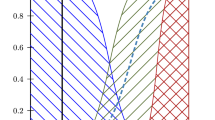Abstract
If we are to build human-like robots that can interact naturally with people, our robots must know not only about the properties of objects but also the properties of animate agents in the world. One of the fundamental social skills for humans is the attribution of beliefs, goals, and desires to other people. This set of skills has often been called a “theory of mind.” This paper presents the theories of Leslie (1994) and Baron-Cohen (1995) on the development of theory of mind in human children and discusses the potential application of both of these theories to building robots with similar capabilities. Initial implementation details and basic skills (such as finding faces and eyes and distinguishing animate from inanimate stimuli) are introduced. I further speculate on the usefulness of a robotic implementation in evaluating and comparing these two models.
Similar content being viewed by others
References
Adams, B., Breazeal, C., Brooks, R., and Scassellati, B. 2000. Humanoid robotics: A new kind of tool. IEEE Intelligent Systems, 15(4):25–31.
Baron-Cohen, S. 1995. Mindblindness, MIT Press: Cambridge, MA.
Breazeal, C., Edsinger, A., Fitzpatrick, P., Scassellati, B., and Varchavskaia, P. 2000. Social constraints on animate vision. IEEE Intelligent Systems, 15(4):32–37.
Breazeal, C. and Scassellati, B. 1999. A context-dependent attention system for a social robot. In 1999 International Joint Conference on Artificial Intelligence.
Breazeal, C. and Scassellati, B. 2002. Infant-like social interactions between a robot and a human caretaker. Adaptive Behavior (to appear).
Brooks, R.A., Breazeal (Ferrell), C., Irie, R., Kemp, C.C., Marjanovi?, M., Scassellati, B., and Williamson, M.M. 1998. Alternative essences of intelligence. In Proceedings of the American Association of Artificial Intelligence (AAAI-98).
Brooks, R.A., Breazeal, C., Marjanovic, M., Scassellati, B., and Williamson, M.M. 1999. The Cog project: Building a humanoid robot. In Computation for Metaphors, Analogy and Agents, C.L. Nehaniv (Ed.), Springer Lecture Notes in Artificial Intelligence, Vol. 1562, Springer-Verlag: Berlin.
Butterworth, G. 1991. The ontogeny and phylogeny of joint visual attention. In Natural Theories of Mind, A. Whiten (Ed.), Blackwell: Oxford, 1988.
Byrne, R. and Whiten, A. (Eds.). Machiavellian Intelligence: Social Expertise and the Evolution of Intellect in Monkeys, Apes, and Humans. Oxford University Press: Oxford.
Carey, S. 1999. Sources of conceptual change. In Conceptual Development: Piaget's Legacy, E.K. Scholnick, K. Nelson, S.A. Gelman, and P.H. Miller (Eds.), Lawrence Erlbaum Associates: New York, pp. 293–326.
Cheney, D.L. and Seyfarth, R.M. 1990. How Monkeys See theWorld, University of Chicago Press: Chicago, IL.
Cheney, D.L. and Seyfarth, R.M. 1991. Reading minds or reading behavior? Tests for a theory of mind in monkeys. In Natural Theories of Mind, A. Whiten (Ed.), Blackwell: Oxford.
Cohen, L.B. and Amsel, G. 1998. Precursors to infants' perception of the causality of a simple event. Infant Behavior and Develoment, 21(4):713–732.
Cox, I.J. and Hingorani, S.L. 1996. An efficient implementation of Reid's multiple hypothesis tracking algorithm and its evaluation for the purpose of visual tracking. IEEE Transactions on Pattern Analysis and Machine Intelligence (PAMI), 18(2):138–150.
Dennett, D.C. 1987. The Intentional Stance, MIT Press: Cambridge, MA.
Fagan, J.F. 1976. Infants' recognition of invariant features of faces. Child Development, 47:627–638.
Fodor, J. 1992. A theory of the child's theory of mind. Cognition, 44:283–296.
Frith, C.D. and Frith, U. 1999. Interacting minds—Abiological basis. Science, 286:1692–1695.
Gelman, R. 1990. First principles organize attention to and learning about relevant data: Number and the animate-inanimate distinction as examples. Cognitive Science, 14:79–106.
Hauser, M. and Carey, S. 1998. Building a cognitive creature from a set of primitives: Evolutionary and developmental insights. In The Evolution of Mind, D.D. Cummins and C. Allen (Eds.), Oxford University Press: New York.
Hauser, M.D. 1996. Evolution of Communication, MIT Press: Cambridge, MA.
Itti, L., Koch, C., and Niebur, E. 1998. A model of saliency-based visual attention for rapid scene analysis. IEEE Transactions on Pattern Analysis and Machine Intelligence (PAMI), 20(11):1254–1259.
Jain, R., Kasturi, R., and Schunck, B.G. 1995. Machine Vision, McGraw-Hill: New York.
Karmiloff-Smith, A., Klima, E., Bellugi, U., Grant, J., and Baron-Cohen, S. 1995. Is there a social module? Language, face processing, and theory of mind in individuals with Williams Syndrome. Journal of Cognitive Neuroscience, 7(2):196–208.
Leslie, A.M. 1982. The perception of causality in infants. Perception, 11:173–186.
Leslie, A.M. 1984. Spatiotemporal continuity and the perception of causality in infants. Perception, 13:287–305.
Leslie, A.M. 1994. ToMM, ToBY, and Agency: Core architecture and domain specificity. In Mapping the Mind: Domain Specificity in Cognition and Culture, L.A. Hirschfeld and S.A. Gelman (Eds.), Cambridge University Press: Cambridge, pp. 119–148.
Michotte, A. 1962. The Perception of Causality, Methuen: Andover, MA.
Mundy, P. and Sigman, M. 1989. The theoretical implications of joint attention deficits in autism. Development and Psychopathology, 1:173–183.
Nothdurft, H.C. 1993. The role of features in preattentive vision: Comparison of orientation, motion and color cues. Vision Research, 33:1937–1958.
Perner, J. and Lang, B. 1999. Development of theory of mind and executive control. Trends in Cognitive Sciences, 3(9):337–344.
Povinelli, D.J. and Preuss, T.M. 1995. Theory of mind: Evolutionary history of a cognitive specialization. Trends in Neuroscience, 18(9):418–424.
Premack, D. 1988. "Does the chimpanzee have a theory of mind?" revisited. In Machiavellian Intelligence: Social Expertise and the Evolution of Intellect in Monkeys, Apes, and Humans, R. Byrne and A. Whiten (Eds.), Oxford University Press: Oxford.
Reid, D.B. 1979. An algorithm for tracking multiple targets. IEEE Transactions on Automated Control, AC-24(6):843–854.
Scassellati, B. 1998. Finding eyes and faces with a foveated vision system. In Proceedings of the American Association of Artificial Intelligence (AAAI-98).
Sinha, P. 1996. Perceiving and recognizing three-dimensional forms. Ph.D. Thesis, Massachusetts Institute of Technology.
Wimmer, H. and Perner, J. 1983. Beliefs about beliefs: Representation and constraining function of wrong beliefs in young children's understanding of deception. Cognition, 13:103–128.
Wolfe, J.M. Guided search 2.0: A revised model of visual search. Psychonomic Bulletin & Review, 1(2):202–238.
Author information
Authors and Affiliations
Rights and permissions
About this article
Cite this article
Scassellati, B. Theory of Mind for a Humanoid Robot. Autonomous Robots 12, 13–24 (2002). https://doi.org/10.1023/A:1013298507114
Issue Date:
DOI: https://doi.org/10.1023/A:1013298507114




